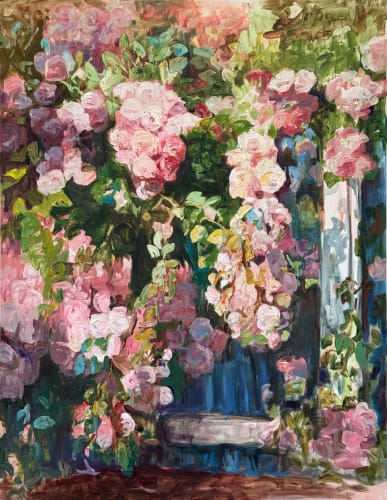Sanderson are pleased to present the exhibition Deep Roots, Tall Poppies - a new exhibition of works by Katherine Throne.
Bringing a fresh and unique perspective to her floral paintings, Katherine Throne chooses to depict flowers growing in her Wanaka garden, and those she finds nearby. Each and every bloom she depicts has gone through the exigencies of the Central Otago climate with its cycles of deep and bitter frost in winter; through the parching drought and unrelenting heat of the summer: a kind of metaphor for the human journey.
Not just deep roots, but plenty of mulch is needed to keep plants alive in this environment. In this exhibition, Throne ventures into still-life, subverting the conventions of the genre. These works convey subtle suggestions about the need to celebrate individuality and buck against prescribed behaviour.
In Best in (today’s) show, she shows how the abundance of her garden can spill out into her studio, providing enough floribunda to fill three containers, with a fourth one waiting to be occupied. The viewpoint is high and oblique, with the bench tilting up and to the right; its brown wooden expanse reaching invitingly towards the viewer. A profusion of summer blooms are bunched into a pale grey vase, anchored against a green backdrop.
It seems as if Throne’s flowers have been tossed almost carelessly into their containers – one appears to tumble out and fall onto the table. But the disarray is artful. The subtle colours – pure white, cream, pale apricot, purple and pink – are energetically applied, and harmoniously balanced. The brilliant white of the double headed rose, radiant against the pinks of the surrounding blooms, sets off a kaleidoscope of colours around it. The heads of each is turned in different directions to catch the clear, bright light and show the unique qualities of each flower; yet they remain generic, never too botanically exact to draw attention away from the ensemble as a whole. Nearby a handful of stems of Queen’s Anne Lace stand up in a tall, glossy red vase which complements their drooping foliage. Secateurs left open on the table, handles toward the viewer, and a few pieces of dropped foliage suggest a quick morning foray into the garden has found these delights.
These casual arrangements are a nod to the mid-twentieth century women artists who pioneered working with floral motifs experimentally. A frequently reproduced photograph of Doris Lusk seated in the studio which she shared with other women artists shows her dressed formally for the opening of her first solo exhibition in 1940. What has always struck me is that the perimeter of the room displays not just Lusk’s paintings, but a dozen or so of her floral arrangements, a remarkable achievement for Dunedin in August. It is possible to read this as a declaration of the importance of gardening and floristry skills, where spring blossom and branches create compositions for vases just as oil pigments and brushes are used to compose paintings. In tune with this approach, Throne describes the arrangements she does for her home in winter as giving her garden a fifth season, indoors.
Near her home in Wānaka, Throne’s keen eye for colour contrasts was caught by a rampant old rose in flagrant bloom, clambering over a Frida Kahlo-blue corrugated iron fence. The result is State of Grace, where the luxuriance of the rose in its abundant floral display conjures perfume in the air, blessing this humble construction with its frothy exuberance. I Dare You further explores the audacity of roses, routinely concealing their sharp thorns while they seduce with their beauty.
In creating these works based on familiar parts of her surroundings and everyday life, Throne chooses unusual angles and compositions, paying particular attention to pattern and the decorative possibilities of each scene. The works have a casual air to them, and the flowers are abstracted into bold shapes, each one carrying its own character. Notice how in Path to Fantasia, based on Throne’s picking garden, there are large ovals on the left and a triangle of tilting pink hollyhocks in the background.
Throne’s celebration of the geometry and liveliness of the natural world, perfectly in balance, indicates how distinctive individuals - tall poppies – might thrive in a culture that extends to them the freedom to grow. At the same time, the artist pushes against the stereotypical conception of flower painting as an unthreatening female accomplishment. Her flowers are loose and lush, animated and untameable. They rejoice in their cultivation in an anti-conformist’s garden, where they will always be free to ramble wherever they want.
Essay by Dr. Linda Tyler

